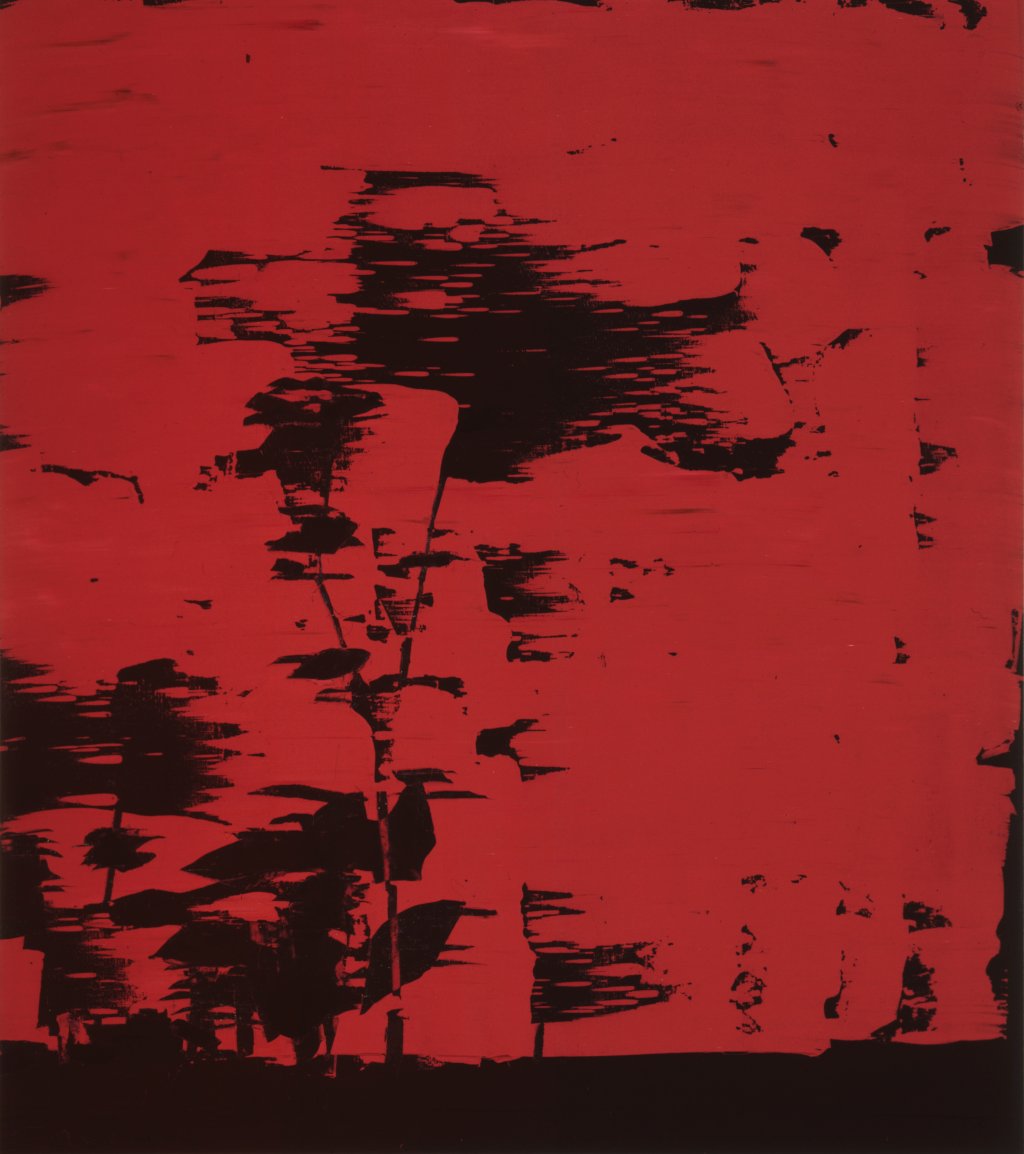CAPTION:
Richard Gorman, Before the Night. Oil on canvas, 1998. Photo
Courtesy of the Christopher Cutts Gallery, Toronto.
I mean “giant” not in the bulky, bodily sense—physically, Richard Gorman (1935-2010) was a rather slight, deft, mercurial sort of guy—but rather as a way of indicating his impressive stature as a visual inventor and trader in aesthetic excellence. And I mean “gentle” for what it is: Rick was remarkably kind, charming, clever, witty and utterly without malice or guile. Everybody liked him.
I met Rick Gorman in the autumn of 1962. I was twenty-two in 1962, and was just about to begin life as a high school English teacher in Hamilton. Already more excited about painting than I was about high-school literature, I used to drive to Toronto every time there was a Saturday afternoon opening at what, in those years, was the epicentre of avantgarde art in Canada, the venerable Isaacs Gallery.
These Isaacs openings were not the gelid cocktail parties an opening is these days. The Isaacs openings were boisterous cultural events: raucous, fervent and somehow, in some palpable way, exhilaratingly serious. They were always packed. There were usually about three hundred people there joyfully crowded into the gallery and spilling out onto Yonge Street, all of them lustily eager to celebrate the achievement of the artist whose opening it was.
It was a Gordon Rayner opening where I met Rick. I was both thrilled and terrified to be there (I knew with leaden accuracy how little I knew about painting). I remember
standing with my back to the wall and watching as Rayner wove his way, movie-star-like, into his applauding crowd of fans, pushing his motorcycle with one arm and clutching a case of beer with the other. A wake of needlessly beautiful young women followed him like the tail of a kite. “This,” I remember thinking, “is the friggin’ life!!”
At which point a slender, rather elfin man came up to me and smiled encouragingly. “Are you having fun?” he asked me. “I think so,” I told him. And then he was gone. As he walked away, I asked the guy next to me if he knew who my well-wisher was. “Sure, that’s Richard Gorman”, he said. Which didn’t mean very much to me at the time.
But I then set about to find out whatever I could about Gorman and his art. I found out he was from Ottawa and had studied with the great painter-teacher Jock Macdonald at the Ontario College of Art in Toronto. I learned he had become part of the famous boys’ club of Isaacs Gallery artists (Michael Snow. Graham Coughtry, Gordon Raymer, John Meredith, Dennis Burton, Robert Markle) in 1959. I learned that he was seriously hard of hearing (from birth) and yet somehow managed to play bass in the infamous Artists’ Jazz Band (a sort of Isaacs Gallery house band). And I was soon to discover that he was producing some of the boldest, hottest abstract paintings in the country (like his monumental Day of Judgement from 1961, quickly purchased that year by the Art Gallery of Ontario).
It was in 1966 that the thirty-one year old Gorman would be selected, along with John Meredith, to represent Canada at the Paris Biennial. The next year his work was featured at Expo 67 in Montreal. And he continued, during the years that followed, to rake in prizes, awards and kudos from everywhere in the Canadian Art world.
Gorman became a relentless explorer of the ways and means of expanding and enriching his painting practice. During the early 1970s, he began wielding a squeegee as a wide, rapid way of pushing paint around. He then turned to the use of a rather brutal scraper, which he employed, with great brio, as a giant palette knife to smooth down his pigments into softer, less highly articulated configurations, leaving effulgent, allover surfaces, rubbed raw as if the canvas had been scoured by warm, eroding winds.
This commingling of painterly nurture (the effects of his preemptive painting tools) and nature (paint obeying its own laws) then led, in the early 1980s, to Gorman’s somewhat surprising reembracing of the idea of landscape as a still legitimate and perpetually challenging subject for serious painting. It was through the agency of landscape, in fact, that he would suddenly set about reinventing himself as an artist.
Respectfully doffing his cap to the venerable Group of Seven painters who were so central a part of this country’s early painting history, Gorman devised for himself a charming alter-ego, a painterly surrogate: an intrepid, post-Group-of-Seven painter he named Jack Pine, who now began plying the Laurentian rivers and lakes north of his native Ottawa in a sleek and very spiffy canoe painted, like a New York Checker Cab, in yellow and black checker board squares—a true water taxi. For a couple of years, Jack Pine paddled about the northland, passionately sketching and painting what he saw—and often more than he saw. For Gorman, this new sojourn in the noble tradition of plein air painting resulted in hundreds of drawings and watercolours that were (Gorman being Gorman) indisputably fresh and lovely.
But they were never meant, on their own, to become the next direction for Gorman’s art. It is one thing to honour art history, but quite another to reinhabit it. In fact, these spontaneous reworkings of the wilderness vignettes passing before him on the shore began to reveal for the painter a powerful and absorbing new way for him to re-enter abstraction.
Gradually, all the trees Gorman witnessed (as Jack Pine) were to coalesce into that quintessential phoneme in the language of wilderness—the single, solitary tree. And the rest of his career would now take the shape of an epic, in-depth exploration of this emblematic figure—the ur-tree Gorman came to see (quoting the poetry of Rilke that he loved so much) as an object of “pure transcendence” (“O tall tree in the ear!”) or, in Gorman’s case, a tall tree in the eye. The galvanizing phrase was from the first of Rilke’s Sonnets To Orpheus (1922), which is why Gorman called his entire decade-long, single tree paintings his Orpheus series.There was a dazzling, comprehensive exhibition of them at Toronto‘s Christopher Cutts Galley in 1999.
The Orpheus painting reproduced here—Gorman’s exquisite Before the Night (1998)—is, like all the paintings in that stellar series, a veritable summa of creative contradiction and synthesis: it is meticulously made, but made spontaneously nevertheless, the rich oil pigment having been swiped sideways (by the reified Gorman squeegee) as if by a chromatic gust of wind. These are solid, monadic images (one tree against one ground), and yet each is informed by a kinetic force that sets up urgent contrasts and contendings in the picture: tree with ground, tree with sky, implacable stillness with a lateral sweep of weather-motion. Facture grappling hard with fruition.
There are many, many Orpheus trees, each a triumph of masterful colour and spatial performance. In Route (1998), for example, the tremulous blue tree is dwarfed by an amalgam of searing magentas. In Newlight (1998), the greyness of both tree and ground have collapsed into the oneness of a glimmering dawn. In the red-orange Ascendency (1998), the molten red tree has been broken by light into a couple of free-floating feathers of red paint, aimless now in the chromatic heat.
As with all the Orpheus paintings, the stalwart, tree of Before the Night, a vibrationin glossy blacks set against a vigorous, brawling red sunset, is planted on the canvas as solidly as a real tree is planted in the earth—but seems, nevertheless, to hover on the picture-plane as pure, arboreal idea.
Maybe each Orpheus tree is, at its core, in essence, the spreading Tree of Life, so central to the structure of world mythologies: as J.E. Cirlot puts it in his indispensable A Dictionary of Symbols (1962), “the symbolism of the tree denotes the life of the cosmos: its consistence, growth, proliferation generative and regenerative processes. It stands for inexhaustible life, and is therefore equivalent to a symbol of immortality.” The tree is an emblem of absolute reality, which is to say, as Cirlot puts it, “the centre of the world.”
In the end, Rick Gorman’s Orpheus trees, employed as his procedural bookmarks in the progress of his craft, as declarations of his particular way of being a serious artist, give abstraction…to borrow a phrase from T. J. Clark’s brilliant book, Farewell to an Idea: Episodes from a History of Modernism (1999)…“a sense of purchase on the world.”
Gorman’s art possessed a gentle relentlessness. It acknowledged and built on the fundamental truths inherent in the enriching confrontation between man and the larger world, between the will of the artist made reverent before the immensities of nature. I miss it. And I miss him.



